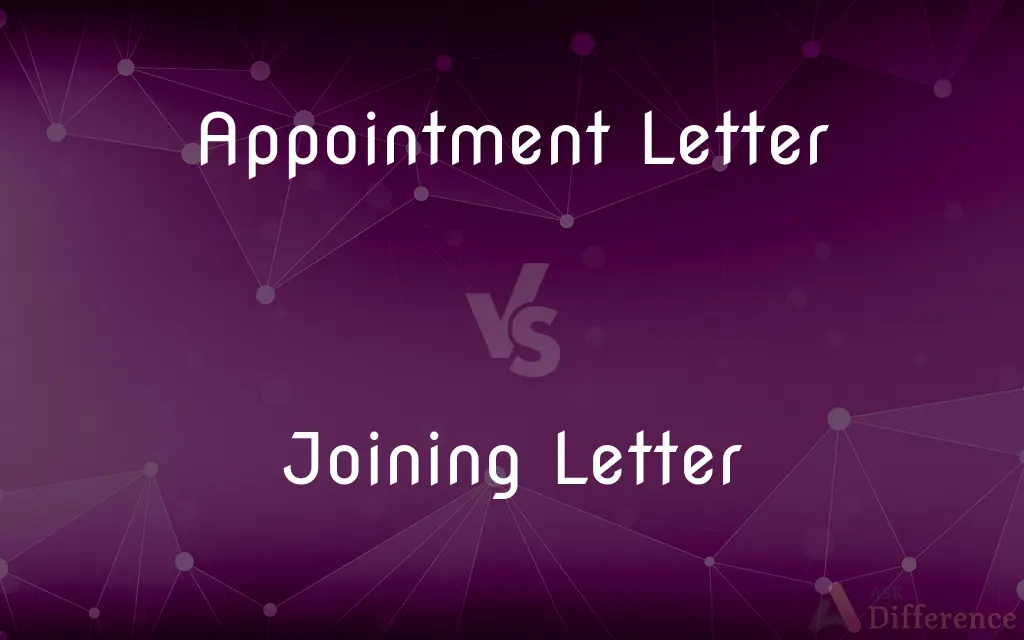Appointment Letter vs. Joining Letter — What's the Difference?
Edited by Tayyaba Rehman — By Fiza Rafique — Published on November 25, 2023
An Appointment Letter formally offers a job to a candidate, outlining terms and conditions. A Joining Letter is typically the candidate's response, confirming their intention to accept and start the job. Both facilitate the hiring process.

Difference Between Appointment Letter and Joining Letter
Table of Contents
ADVERTISEMENT
Key Differences
An Appointment Letter is an official document that a company issues to a prospective employee. It serves as a formal job offer, outlining the position, terms of employment, salary, and other associated details. In contrast, a Joining Letter is a written communication from the candidate, usually addressing the employer, indicating their acceptance of the offered position and the date they intend to start.
The Appointment Letter plays a crucial role in the recruitment process. It ensures that both the employer and the employee are on the same page regarding the job's specifics. The Joining Letter, on the other hand, acts as a confirmation from the candidate's side, signifying their commitment to join the organization and their acknowledgment of the terms laid out in the Appointment Letter.
While the Appointment Letter acts as a bridge between the interview phase and the onboarding phase, providing clarity and setting expectations, the Joining Letter aids in logistical aspects. With the Joining Letter, HR departments can prepare for the new hire's onboarding, ensuring that all necessary arrangements are in place for the employee's first day.
In essence, while both the Appointment Letter and the Joining Letter are critical in the hiring process, they serve distinct functions. The Appointment Letter is an offer, and the Joining Letter is an acceptance. Both are necessary to establish clear communication and smooth transition during hiring.
Comparison Chart
Primary Function
Offers a job position to a candidate
Confirms acceptance of the job offer by a candidate
ADVERTISEMENT
Issued by
Employer or HR department
Candidate or new hire
Contains
Job details, terms, salary, etc.
Start date, acknowledgment of terms, etc.
Purpose
Formalize job offer and set terms
Confirm intent to join and start date
Role in Recruitment
Transition from selection to onboarding
Final step before actual onboarding
Compare with Definitions
Appointment Letter
A letter that sets expectations and conditions for a job role.
The Appointment Letter also contained a clause about the probation period.
Joining Letter
A document that communicates a candidate's intent to onboard.
The Joining Letter I submitted helped the company prepare for my arrival.
Appointment Letter
A letter bridging the gap between selection and onboarding.
The HR department issued an Appointment Letter outlining my roles and responsibilities.
Joining Letter
A written response confirming the acceptance of a job offer.
I sent the Joining Letter indicating my start date next month.
Appointment Letter
A written proposal for employment from an organization.
Before accepting the job, I thoroughly reviewed the Appointment Letter.
Joining Letter
A formal acceptance of the terms listed in the Appointment Letter.
My Joining Letter also included any clarifications I needed regarding the job terms.
Appointment Letter
A formal document offering a job position to a candidate.
After the final interview, I received an Appointment Letter from the company.
Joining Letter
A final step in the recruitment process before the actual onboarding.
After the Joining Letter, they sent me the orientation schedule.
Appointment Letter
An official communication detailing the terms of employment.
The Appointment Letter clarified the salary package and other benefits.
Joining Letter
A letter from the candidate to the employer acknowledging job terms.
The HR manager appreciated my prompt response with the Joining Letter.
Common Curiosities
What details are mentioned in the Appointment Letter?
The Appointment Letter mentions job details, salary, benefits, terms of employment, and other relevant information.
Who typically issues the Appointment Letter?
The employer or the HR department of the company usually issues the Appointment Letter.
Is the Joining Letter a mandatory step in the hiring process?
While not always mandatory, the Joining Letter is a common practice to confirm and finalize the hiring process.
When should a candidate send the Joining Letter?
Ideally, a candidate should send the Joining Letter soon after receiving and reviewing the Appointment Letter.
What is the primary purpose of an Appointment Letter?
The Appointment Letter formally offers a job to a candidate, outlining the terms and conditions.
What does a Joining Letter signify?
A Joining Letter signifies a candidate's intention to accept the job and states their start date.
Can an Appointment Letter be withdrawn by the employer?
Yes, but it's rare and usually due to unforeseen circumstances. Legal implications may arise depending on the terms.
From whom does the Joining Letter originate?
The Joining Letter originates from the candidate or the new hire.
What happens if a candidate doesn't send a Joining Letter?
If a Joining Letter isn't sent, it may be assumed the candidate is not joining, and the offer might be rescinded.
Are both letters legally binding?
The Appointment Letter can be legally binding, depending on its content. The Joining Letter is an acknowledgment but may not be as binding.
Can terms be negotiated after receiving an Appointment Letter?
Yes, candidates often discuss and negotiate terms before sending the Joining Letter.
How long is the validity of an Appointment Letter?
The validity varies but is typically specified in the letter itself.
Should the Joining Letter match the details in the Appointment Letter?
Ideally, yes. The Joining Letter should align with the terms provided in the Appointment Letter.
Can there be multiple rounds of Appointment Letters and Joining Letters?
Typically, no. However, if terms are renegotiated, a new Appointment Letter might be issued, followed by a new Joining Letter.
What if there's a discrepancy between the Appointment Letter and Joining Letter?
Discrepancies should be addressed immediately with HR to ensure a clear understanding and agreement.
Share Your Discovery

Previous Comparison
A4 vs. Legal Paper Size
Next Comparison
Fibrillation vs. FasciculationAuthor Spotlight
Written by
Fiza RafiqueFiza Rafique is a skilled content writer at AskDifference.com, where she meticulously refines and enhances written pieces. Drawing from her vast editorial expertise, Fiza ensures clarity, accuracy, and precision in every article. Passionate about language, she continually seeks to elevate the quality of content for readers worldwide.
Edited by
Tayyaba RehmanTayyaba Rehman is a distinguished writer, currently serving as a primary contributor to askdifference.com. As a researcher in semantics and etymology, Tayyaba's passion for the complexity of languages and their distinctions has found a perfect home on the platform. Tayyaba delves into the intricacies of language, distinguishing between commonly confused words and phrases, thereby providing clarity for readers worldwide.
















































